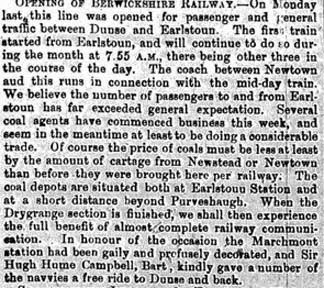A Look at the Historic Bridges around Earlston.
CRAIGSFORD BRIDGE
Craigsford Bridge over the Leader Water was built around 1737. Until the building of the new toll road (the later A68) at the end of the century, it was the main route to Edinburgh. Sometimes it is referred to as the Mill Brig.
Craigsford Bridge over the Leader Water was built around 1737. Until the building of the new toll road (the later A68) at the end of the century, it was the main route to Edinburgh. Sometimes it is referred to as the Mill Brig.

A modern view of the bridge
LEADER BRIDGE
The Leader road bridge
with the Craigsford Bridge and Simpson & Fairbairn Mill in the background.
RAIL BRIDGES AT EARLSTON
A wintry view in 1955 of what was known as the Tin Brig,
carrying the railway line through Earlston.
with the Craigsford Bridge and Simpson & Fairbairn Mill in the background.
RAIL BRIDGES AT EARLSTON
The rail bridge over the Leader water was demolished in 1989, 24 years after the last train ran through Earlston,
A wintry view in 1955 of what was known as the Tin Brig,
carrying the railway line through Earlston.
CAROLSIDE BRIDGE
The graceful late 18th century bridge spanning the Leader Water links the neighbouring estates of Carolside and Leadervale.
"The Statistical Account of Scotland" of 1834 in the chapter on Earlston gives us a beautiful description of Carolside
"Poised on a green plateau beside the River Leader and sheltered by surrounding slopes of its own extensive woodlands, as a sweet and secure asylum from the toils and troubles of the world'."
Over the years, the Carolside estate was used by Earlston Girl Guides, Earlston Cricket Club, for Home Guard training in the Second World War and as the location for the 1934 Ercildoune Pageant, depicting scenes from local history.
Two views of the bridge in more recent times:
A lovely view of the Leader valley, looking down on the little Carolside Bridge.
Carolside Bridge - July 2017
THE THREE LEADERFOOT BRIDGES
An
unusual view of the lower old Dryburgh road bridge built 1776-80. It replaced a ferry crossing over the River Tweed, on the route
that is now the main A68 north to Edinburgh. Its narrow structure, more
used to horses and carts, remained in use for 200 years, until a new
road bridge spanned the river in 1974.
In the background
is the famous Leaderfoot Viaduct built in 1865 and the major engineering feat of the Berwickshire Railway
Line from the east to cross the River Tweed. The statistics are impressive - the
viaduct stands 126 feet (38 m) from the floor of the river valley, and
its 19 arches, each has a 43 feet span. Interestingly it was referred to in a newspaper article of
December 1864 as the Drygrange Viaduct.
The Berwickshire Railway was badly affected by
severe flooding in 1948 and services to the east of the county were particularly affected. The last train ran over the viaduct in 1965. It is now under the care of Historic Environment Scotland.
A charming tinted photograph, c.1900.

A steam train crossing the Leaderfoot Viaduct, c. 1959
One of the last trains over Leaderfoot in 1965
Copyright © Bruce McCartney All Rights Reserved.
at http://www.geoffspages.co.uk/monorail/bmcc01.htm
at http://www.geoffspages.co.uk/monorail/bmcc01.htm

The Viaduct
remains a popular spot for photographers today - here a view taken
from the old road bridge which is now only open to walkers and cyclist.
A view of the three bridges, spanning two hundred years of history.
***********
to the Auld Earlston collection.
We are always pleased to receive
further photographs, postcards and documents on the village.
Please contact: E-Mail: auldearlston@aol.com






















